The story broke on February 27 in both the Berkeley News, a publication of the University of California, Berkeley and the science journal Nature. The DNA in beer-producing saccharomyces yeast has been commandeered to make cannabinoids instead of alcohol. In the Berkeley News article, lead researcher Jay Keasling, a Berkeley professor of chemical and biomedical engineering, commented that the goal is production of “high-quality, low-cost” cannabinoids in a “more environmentally friendly way” that can be precisely controlled.
According to Nature, at least ten companies are vying to perfect the process, hoping one day to produce enough THC or CBD to sell to the pharmaceutical industry. Professor Keasling founded one such company called Demetrix and got National Science Foundation support. They’ll definitely need to up-scale the process; right now, they’re getting one percent of the supply needed to compete with plant-extraction methods.
Not that it’s easy to do. Nature reported that it takes 16 genetic modifications to program these single-celled micro-organisms for the task. Motherboard.com announced the first steps toward THC production in July 2014, noting that the right coding genes had been discovered in 2009. In September 2015, Motherboard writer Jason Koebler reported on German scientists’ success in making a tiny amount of THC. From there, the race was on.

According to Koebler, producing enough to be useful is the hard part and may take another two years. Genetic engineers are busy modifying bacteria and yeast for all sorts of production tasks and struggle with up-scaling the quantity all the time. Jay Keasling’s research group was noted in a March 1 Popular Mechanics article and on his lab website (keaslinglab.lbl.gov) for using engineering yeast to produce an anti-malaria drug and others that convert plant waste into biofuel, but the amounts produced were not disclosed. Koebler pointed out that the process of engineering yeast to produce morphine, first reported in Science in May 2015, must be ramped up 400,000 times to equal plant-extraction methods.
As Koebler explained in Motherboard, normally when brewer’s yeast cells eat galactose, the sugar they prefer, it is converted into alcohol. After many insertions of genes from the cannabis plant, the yeast cells can be instructed to produce THC, CBD or any of a whole array of natural and synthetic cannabinoids, with the hope of tailoring production to specific medical treatments. In Nature, Keasling commented that his group is most interested in those other, less well-known cannabinoids. Some naturally occur in the cannabis plant but in such small quantities that they are hard to isolate for study. Still other cannabinoids have never been seen in nature. Naturally occurring or not, some may have therapeutic benefits, and the lab-created ones could be patented, too, a potential economic boon.
Keasling called brewer’s yeast cells, “green drug factories,” meaning environmentally green. The Berkeley News article cited the environmental damage caused by large-scale cannabis-growing and extraction operations and contrasted that with the genetic engineering process in development. Of course, there are those who say genetic engineering is, by definition, not environmentally friendly. Those who feel that way may cheer the research of UCLA microbiologist Jim Bowie, reported in the March 1 Popular Mechanics article. Bowie is working to chemically convert sugars directly into cannabinoids without the need of any yeast intermediaries.
On the therapeutic side, there’s the entourage effect to consider. That’s the poorly understood synergistic effect of all those natural cannabinoids interacting in the body. Many say there is simply no substitute for using the whole plant. However, drug R&D is based on federal rules requiring the isolation of single chemicals for study. All of the companies currently competing to crack the up-scaling problem hope to make money selling their pure cannabinoids to pharmaceutical companies or directly to the public under FDA oversight.
In a related story, United Press International reported in March 2017 that University of British Columbia (UBC) scientists have isolated the genes that produce the various main flavors in cannabis, the terpenes. The goal is the production of “well-defined and highly reproducible cannabis varieties” analogous to wine varieties like merlot and chardonnay. The UBC group has isolated limonene (the citrus-flavored terpene), myrcene (the dank, earthy one), and pinene (the pine resin one). They’ve found thirty terpene-regulating genes so far, promising the production of more favorite flavors. This may give new meaning to the term craft beer and bring visions of delight to the beer-and-bong crowd. Imagine sauntering into your local brewpub and ordering a high-THC Blue Dream, GSC or Sour Diesel brew on tap. Truly, this would give new meaning to partying everywhere!



Leave a Reply